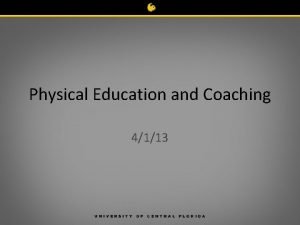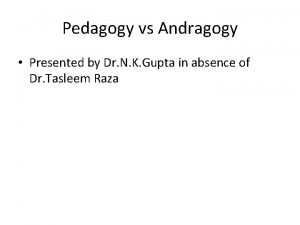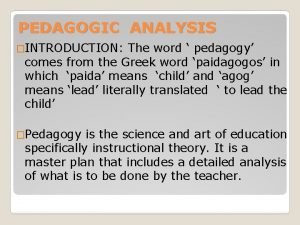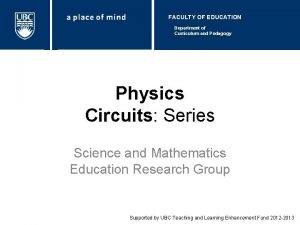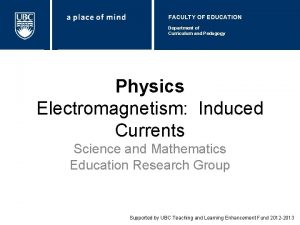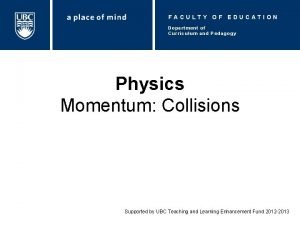FACULTY OF EDUCATION Department of Curriculum and Pedagogy




















- Slides: 20

FACULTY OF EDUCATION Department of Curriculum and Pedagogy Physics Circuits: Short Circuits Science and Mathematics Education Research Group Supported by UBC Teaching and Learning Enhancement Fund 2012 -2013

Short Circuits and Switches

Short Circuits and Switches I A battery with potential difference ΔV = 9 V and a light bulb are connected in series. A segment of wire is removed as shown. What is the potential difference between Point A and Point B? A. Infinite ΔV = 6 V B. 6 V Point A Point B C. 3 V D. 0 V E. Depends on the resistance of the bulb

Solution Answer: B Justification: The positive terminal of the battery has a potential of 6 V. The negative end of the terminal must be 0 V in order for there to be a potential difference of 6 V. The potential difference in a circuit cannot exceed that of the battery. The gap in the circuit means that there is no current in the circuit, and there are no potential drops across any of the circuit elements. The potential will be the same at any point before the bulb and any point after the bulb before the gap. Therefore, the potential at A is the same as the positive terminal of the battery, and the potential at B is the same as the negative terminal. The potential difference between A and B will be same as the battery.

Short Circuits and Switches II Three identical bulbs are connected in series as shown. Bulb 2 happens to burn out. Which of the other bulbs go out? Bulb 1 A. Only Bulb 1 Bulb 2 + B. Only Bulb 3 C. Both 1 and 3 – D. No bulbs go out Bulb 3

Solution Answer: C Justification: When Bulb B burns out, a gap in the circuit is formed: + – No current will flow through this circuit. Since no current flows in the circuit, there is no potential difference across either of the two remaining bulbs. All the bulbs in series with Bulb 2 will go out.

Short Circuits and Switches III A single battery and two identical light bulb are connected in a series circuit. Suppose a zero resistance wire is connected across Bulb B as shown in red. When the wire is connected, what happens to the brightness of Bulb B? A. Increases Bulb A + B. Stays the same C. Decreases – D. Decreases to zero Bulb B E. Depends on the resistance of the bulb

Solution Answer: D Justification: The red wire and Bulb B are connected in parallel. Current will always choose the path of least resistance. The red wire has no resistance, so all of the current flows through that path. There is no potential drop across a zero resistance wire, and the wire puts both ends of Bulb B at the same potential. Since I = V/R, and the voltage drop across B is zero, there must be no current through Bulb B. The power dissipated by the light bulb must be 0 W and therefore the light bulb goes out.

Short Circuits and Switches IV A single battery and two identical light bulb are connected in a series circuit. Suppose a zero resistance wire is connected across Bulb B as shown in red. When the wire is connected, what happens to the brightness of Bulb A? A. Increases Bulb A + B. Stays the same C. Decreases – D. Decreases to zero Bulb B E. Depends on the resistance of the bulb

Solution Answer: A Justification: Before the red wire is connected, two identical bulbs are in series, so the potential drop across each bulb is equal to half the potential difference of the battery. After the red wire is connected, the circuit becomes a series circuit with only 1 bulb. Bulb A Current will choose the path of least resistance, + and ignores the second light bulb. The potential – difference across the remaining bulb is equal to the potential difference across the battery. Power is proportional to the square of potential difference, so an increase in potential difference will cause an increase in power. With twice the potential difference, the bulb dissipates 4 times as much energy.

Short Circuits and Switches V Two identical bulbs and a switch are connected in parallel as shown. When the switch is open, which of the bulbs are lit? + – 1 2 A. Only Bulb 1 B. Only Bulb 2 C. Both 1 and 2 D. Neither 1 or 2

Solution Answer: C Justification: The open switch has no effect on the two bulbs in parallel. No current will pass through the branch with the switch when it is open. The order in which the branches are depicted left to right has no effect on the amount of current that reaches each branch. The open switch on the second branch does not current off from the third branch, and bulb 2. + – 1 2

Short Circuits and Switches VI Two identical bulbs and a switch are connected in parallel as shown. When the switch is closed, which of the bulbs are lit? + – 1 2 A. Only Bulb 1 B. Only Bulb 2 C. Both 1 and 2 D. Neither 1 or 2

Solution Answer: D Justification: Current will always choose the path with least resistance. The middle branch provides no resistance, so no current will move through the light bulbs. In other words, the current will choose the middle brunch as a shortcut (thus the term a short circuit). + – I II

Short Circuits and Switches VII Five identical bulbs are connected in a circuit as shown. The switch is currently open. How do the brightnesses of the bulbs compare? 1 A. 1 = 2 = 5 > 3 > 4 + B. 3 = 4 > 1 = 2 = 5 2 3 – C. 1 = 5 > 2 > 3 = 4 D. 1 = 5 > 3 = 4 > 2 E. 1 = 5 > 2 = 3 = 4 5 4

Solution Answer: C Justification: P = I 2 R. Since all of the bulbs have the same resistance, power will be determined by the amount of current. Bulb 1 and 5 are connected directly in series with the battery, and have the maximum current flowing through them. They will be the brightest. Bulb 2 is in parallel with bulb 3 and 4, which are in series together. Since the branch with two bulbs has twice the resistance as the branch with only one bulb, there will be half as much current through this branch. The branch with bulb 2 draws more current, so it will be brighter than 2 and 4. 3 and 4 are in series with each other, so they have the same current through them, and thus the same amount of power. The bulbs from brightest to dimmest will then be: 1=5>2>3=4

Short Circuits and Switches VIII Five identical bulbs are connected in a circuit as shown. The switch is now closed. Which of the 5 bulbs go out, if any? 1 A. None of the bulbs B. Only 3 + 2 3 – C. All of the bulbs D. 3 and 4 E. 2, 3, and 4 5 4

Solution Answer: B Justification: The circuit can be redrawn as shown. Notice that because of the location of the junction, the short circuit is only in parallel with Bulb B. Similar to question 2, the potential difference across Bulb 3 is now 0 V, so there will be no current through the bulb and it will dissipate no power. 1 The other bulbs are not connected to the short circuit, and will + continue to receive current. 2 3 – 4 5

Short Circuits and Switches IX Five identical bulbs are connected in a circuit as shown. The switch is now closed. How do the brightnesses of the bulbs compare? 1 A. 1 = 5 > 2 = 4 > 3 + B. 1 = 5 > 2 > 4 > 3 2 3 – C. 1 = 5 > 4 > 2 > 3 D. 1 = 5 > 2 > 3 = 4 E. 1 = 2 = 5 > 4 > 3 5 4

Solution Answer: A Justification: Bulbs 1 and 5 are again the brightest because all of the current flows through each of them. As discussed in the previous question, Bulb 3 is now connected in parallel to a wire with no resistance, and no current flows through it. It is the only bulb that is not lit, and thus the least bright. Bulbs 4 and 2 are the same brightness because they are connected in parallel to each other and have the same resistance. Having the same resistance means that each branch draws the same amount of current. The bulbs from brightest to dimmest will then be: 1 = 5 > 2 = 4 > 3 1 + 2 3 – 4 5
 Education scotland play pedagogy toolkit
Education scotland play pedagogy toolkit Gde vision and mission 2021
Gde vision and mission 2021 Nit calicut chemistry faculty
Nit calicut chemistry faculty Georgia teacher academy for preparation and pedagogy
Georgia teacher academy for preparation and pedagogy Sport pedagogy definition
Sport pedagogy definition Advanced pedagogy and application of ict
Advanced pedagogy and application of ict Epistemology and pedagogy
Epistemology and pedagogy Importance of faculty in higher education
Importance of faculty in higher education Myfile yorku
Myfile yorku Faculty of education
Faculty of education Chronicle of higher education faculty salaries
Chronicle of higher education faculty salaries Faculty of education khon kaen university
Faculty of education khon kaen university Techno-pedagogy
Techno-pedagogy Public pedagogy definition
Public pedagogy definition Pedagogical vs andragogical
Pedagogical vs andragogical Gogy meaning in english
Gogy meaning in english Example of equity pedagogy
Example of equity pedagogy Gender responsive pedagogy
Gender responsive pedagogy Social pedagogy
Social pedagogy Randstad pronunciation
Randstad pronunciation Pedagogy analysis
Pedagogy analysis




